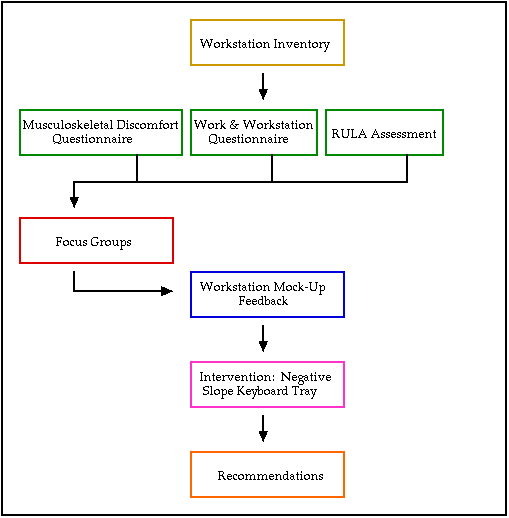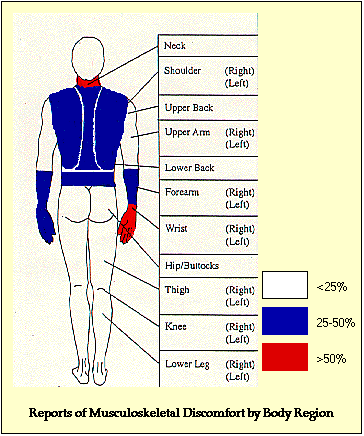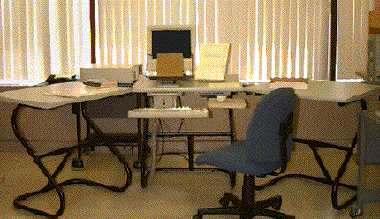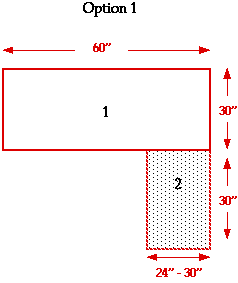
Cornell University Ergonomics Web
Participatory Ergonomics in a University Library
An Case Study
Master's Thesis
By Dena
Tepper
Committee Chair: Alan
Hedge
Minor Member: Paul Eshelman
Background
Library Automation
- By 1984 almost all librarians were using VDTs to some extent
- By 1987 the work of library staff had changed dramatically from the
work performed as little as five or even one year earlier (Vasi, 1987).
- The rapid increase of computers in libraries has not been accompanied
by changes in workstation
design (Busch 1984; Vasi, 1987; Olsgaard, 1989).
Libraries and computer related injuries
- As early as 1986 reports of VDT related injuries appeared in
library publications
- A survey of 58 public libraries conducted in 1990 revealed that of 38
responding libraries, seventeen libraries (44.7%) reported one or more of
their employees with CTS or "related injury" (Kusack, 1990).
Previous Research on Libraries
Library Workstation Requirements Identified
Sufficient worksurface:
- Michaels et al. (1992) recommend 80 square feet as a basic library
staff workstation
- Wilkinson et al. (1993) recommend that two feet of work space be
provided on at least one side of the VDT
Worksurface height:
- Ideally worksurface height should be adjustable (Steinhagen, 1992;
Wright et al., 1992; Michaels, 1992; Kusack, 1990).
Purpose of the Study
The purpose was to conduct a systematic investigation and to develop a
set of recommendations for the purchasing of furniture. Emphasis was
to be placed on accommodating tasks and equipment which are specific to the
library environment. Involvement of library staff in the process was
to be stressed.
Here are a couple of examples of workstations at the Library:
| This picture is an example of
a workstation which is not well suited to computer work. Here an old typewriter
stand is being used for a computer, providing no adjustablility to the work
surface. A lumbar support has been added to a chair which meets almost none of
the requirements for ergonomic design and the arrangement of the workstation,
specifically the location of the two garbage pails leaves little leg
room. |  |
| This picture when compared to
the previous one is a good illustration of the variability in the workstations
at the library. This is an example of a "newer" workstation. The
piles of books and other materials on either side of the keyboard are a perfect
illustration of one of the major concerns raised in the focus groups, namely the
need for more surface area. |  |
After doing an initial walkthrough and completing an inventory of the
current workstations a study process was developed. Four methods were
chosen to evaluate the current situation:
- Postural Analysis using RULA completed by myself and an assistant
- Musculoskeletal Discomfort Survey distributed to all employees asking
them to indicate location and extent of discomfort
- Workstation Evaluation Survey distributed to all employees asking them
to evaluate elements of their current workstation
- Focus Groups conducted by myself with representatives of each task
group in order to determine the design needs of each task group
- Mock-up workstation set up in the library
- Intervention
The following diagram illustrates this study process:

Results
 Musculoskeletal Discomfort Survey
Musculoskeletal Discomfort Survey
The figure on the right illustrates the areas of discomfort reported by the
library employees represented by % of reportees. It is clear from these
results that the areas for which discomfort was most commonly reported are
the right wrist and the neck.
RULA Postural Analysis
RULA provides a score which is indicative of the extent to which a person
is at risk for injury, the higher the score the greater the risk to the
individual. The table below is a listing of the mean scores for all the
subjects broken down into component parts. In this way it is possible to
determine what parts of the body are contributing the most to the total
score. The results indicate that it is the posture of the wrist and neck
which are putting subjects at the greatest risk for injury.
| RULA
Assessment |
| MEAN | Upper Arm | Lower Arm | Wrist | Neck | Trunk | Leg | Final Score |
| 1.94 | 2.12 | 2.90 | 3.02 | 1.98 | 1.00 | 3.73 |
The data from the self-report survey and the observational RULA measurement
concur, indicating that the areas of greatest concern were the neck and
wrist.
After analyzing the data a workstation mock-up was set up in the library.
The mock-up consisted of three tables which were attached by hinges and
could be arranged in a variety of horizontal configurations. A negative
slope keyboard tray and a mouse tray were attached to the center table.
The purpose of the mock-up was to collect information on horizontal layout
preferences of library staff. All library employees had an opportunity to
try the workstation and provide feedback on their preferred layout and the
comfort of the keyboard system. The Mock-Up

Workstation Recommendations
Workstation options:
- desk with right return
- desk with left return
- desk with two returns



- Panel systems allow for height adjustable worksurfaces, returns can
be set at different heights than the primary worksurface. Freestanding
desks are generally fixed height.
- Panel systems also allow for overhead storage which is generally not
possible with freestanding desks.
Primary worksurface depth: minimum 30" to allow for
document/book holder in front of monitor
Primary worksurface width: minimum 60" with one return (24" depth)
minimum 66" with two returns (24" depth)
Return depth: 24" if it is not used as a computer surface;
30" if there is a chance the computer will go there.
Return width: minimum 30"
Storage:
- small drawers for office supplies
- large drawers for files and personal belongings
These can be accomplished with a rolling pedestal which is
low enough that it will not
restrict the full height adjustability
of the panels
- shelves for reference materials and books
Shelves a varying sizes can be attached to panel systems even
with a panel 54" high
Keyboard system: there should be a keyboard system, like
the Proformix system tested in this study, attached to the workstation
which can accommodate both the keyboard and mouse. Keyboard system should
be both height adjustable and angle adjustable to below 0 degrees.
Choice of document holders including: Bookholder
which can accommodate books of varying sizes, small paper document holder,
document holder to accommodate large documents (e.g. printouts).
For more information please contact  Dena Tepper
Dena Tepper
A useful resource on Library ergonomics: UT Austin General Libraries
Ergonomics Task Force
See the Project Slideshow
Return to the CUergo Home Page.




 Musculoskeletal Discomfort Survey
Musculoskeletal Discomfort Survey


